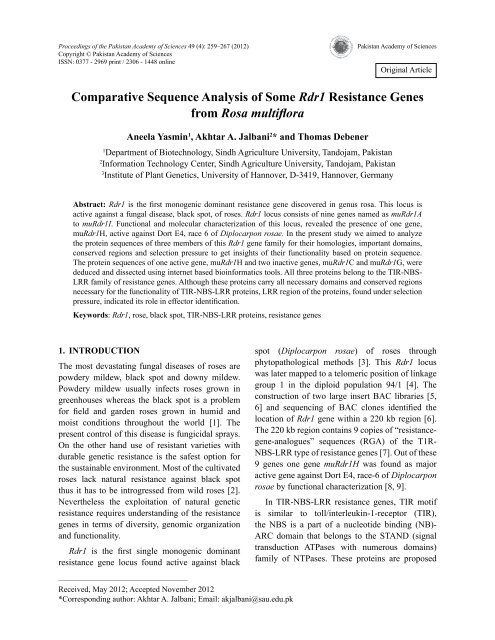Download Full Journal - Pakistan Academy of Sciences
Download Full Journal - Pakistan Academy of Sciences
Download Full Journal - Pakistan Academy of Sciences
You also want an ePaper? Increase the reach of your titles
YUMPU automatically turns print PDFs into web optimized ePapers that Google loves.
Proceedings <strong>of</strong> the <strong>Pakistan</strong> <strong>Academy</strong> <strong>of</strong> <strong>Sciences</strong> 49 (4): 259–267 (2012) <strong>Pakistan</strong> <strong>Academy</strong> <strong>of</strong> <strong>Sciences</strong><br />
Copyright © <strong>Pakistan</strong> <strong>Academy</strong> <strong>of</strong> <strong>Sciences</strong><br />
ISSN: 0377 - 2969 print / 2306 - 1448 online<br />
Original Article<br />
Comparative Sequence Analysis <strong>of</strong> Some Rdr1 Resistance Genes<br />
from <br />
Aneela Yasmin 1 , Akhtar A. Jalbani 2 * and Thomas Debener<br />
1<br />
Department <strong>of</strong> Biotechnology, Sindh Agriculture University, Tandojam, <strong>Pakistan</strong><br />
2<br />
Information Technology Center, Sindh Agriculture University, Tandojam, <strong>Pakistan</strong><br />
3<br />
Institute <strong>of</strong> Plant Genetics, University <strong>of</strong> Hannover, D-3419, Hannover, Germany<br />
Abstract: Rdr1 <br />
active against a fungal disease, black spot, <strong>of</strong> roses. Rdr1 locus consists <strong>of</strong> nine genes named as muRdr1A<br />
to muRdr1I. Functional and molecular characterization <strong>of</strong> this locus, revealed the presence <strong>of</strong> one gene,<br />
muRdr1H, active against Dort E4, race 6 <strong>of</strong> Diplocarpon rosae. In the present study we aimed to analyze<br />
the protein sequences <strong>of</strong> three members <strong>of</strong> this Rdr1 gene family for their homologies, important domains,<br />
conserved regions and selection pressure to get insights <strong>of</strong> their functionality based on protein sequence.<br />
The protein sequences <strong>of</strong> one active gene, muRdr1H and two inactive genes, muRdr1C and muRdr1G, were<br />
deduced and dissected using internet based bioinformatics tools. All three proteins belong to the TIR-NBS-<br />
LRR family <strong>of</strong> resistance genes. Although these proteins carry all necessary domains and conserved regions<br />
necessary for the functionality <strong>of</strong> TIR-NBS-LRR proteins, LRR region <strong>of</strong> the proteins, found under selection<br />
<br />
Keywords: Rdr1, rose, black spot, TIR-NBS-LRR proteins, resistance genes<br />
1. INTRODUCTION<br />
The most devastating fungal diseases <strong>of</strong> roses are<br />
powdery mildew, black spot and downy mildew.<br />
Powdery mildew usually infects roses grown in<br />
greenhouses whereas the black spot is a problem<br />
<br />
moist conditions throughout the world [1]. The<br />
present control <strong>of</strong> this disease is fungicidal sprays.<br />
On the other hand use <strong>of</strong> resistant varieties with<br />
durable genetic resistance is the safest option for<br />
the sustainable environment. Most <strong>of</strong> the cultivated<br />
roses lack natural resistance against black spot<br />
thus it has to be introgressed from wild roses [2].<br />
Nevertheless the exploitation <strong>of</strong> natural genetic<br />
resistance requires understanding <strong>of</strong> the resistance<br />
genes in terms <strong>of</strong> diversity, genomic organization<br />
and functionality.<br />
Rdr1 <br />
resistance gene locus found active against black<br />
spot (Diplocarpon rosae) <strong>of</strong> roses through<br />
phytopathological methods [3]. This Rdr1 locus<br />
was later mapped to a telomeric position <strong>of</strong> linkage<br />
group 1 in the diploid population 94/1 [4]. The<br />
construction <strong>of</strong> two large insert BAC libraries [5,<br />
<br />
location <strong>of</strong> Rdr1 gene within a 220 kb region [6].<br />
The 220 kb region contains 9 copies <strong>of</strong> “resistancegene-analogues”<br />
sequences (RGA) <strong>of</strong> the T1R-<br />
NBS-LRR type <strong>of</strong> resistance genes [7]. Out <strong>of</strong> these<br />
9 genes one gene muRdr1H was found as major<br />
active gene against Dort E4, race-6 <strong>of</strong> Diplocarpon<br />
rosae by functional characterization [8, 9].<br />
In TIR-NBS-LRR resistance genes, TIR motif<br />
is similar to toll/interleukin-1-receptor (TIR),<br />
the NBS is a part <strong>of</strong> a nucleotide binding (NB)-<br />
ARC domain that belongs to the STAND (signal<br />
transduction ATPases with numerous domains)<br />
family <strong>of</strong> NTPases. These proteins are proposed<br />
————————————————<br />
Received, May 2012; Accepted November 2012<br />
*Corresponding author: Akhtar A. Jalbani; Email: akjalbani@sau.edu.pk

















